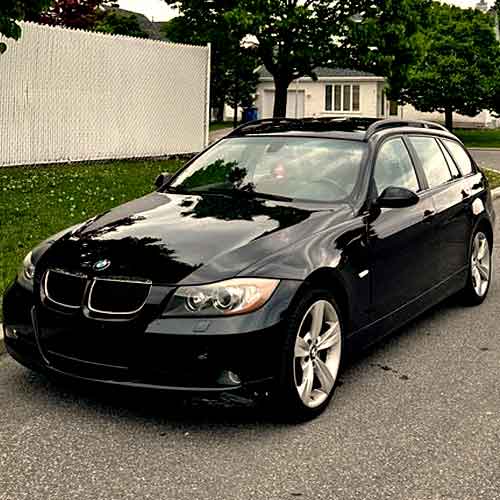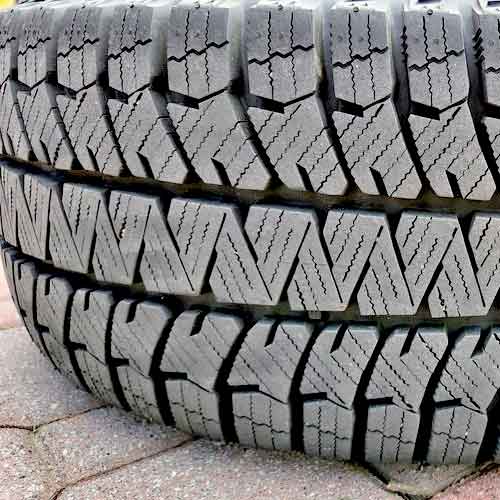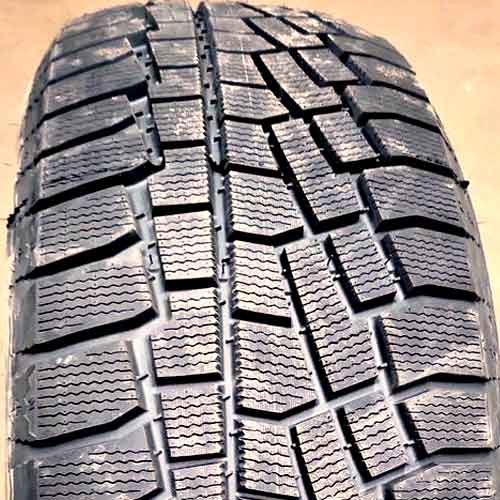Up for comparison are the Cooper Discoverer True North, renowned for its sturdy construction and dependability, and the Bridgestone Blizzak WS90, celebrated for its comprehensive winter performance. Who will come out on top in this tire tug-of-war?

Table of Contents
Tire Sizes
The Cooper Discoverer True North comes in 15 to 20 inches, having following.
- Speed ratings: H and T.
- Load ratings: SL and XL.
- Tread depth: 11/32″ on all.
- Weight: 21 to 34 lbs.
On the other side, the Bridgestone Blizzak WS90 comes in 52 total sizes in 15 to 19 inches (wheels) with following specs.
- Speed ratings: T or H.
- Load ratings: SL or XL.
- Tread depth: 11 or 12/32″.
- Weight: 17 to 29 lbs.
Review this tire in greater detail: https://snowytires.com/bridgestone-blizzak-ws90-review/
Tread Appearance
The Bridgestone Blizzak WS90 is a strong winter tire with a carefully planned tread pattern. Let’s take a closer look at its features.

The outside of the tire, or the tread, has three parts, where two outer ribs are shoulders and then we have the one in the middle.
Talking about the outer ribs first, you see a lot of biting edges there.
There are slanted full depth notches facing the middle. And then there are similar types of notches, though they face longitudinally.
(This way, the tire is able to bite in both directions).
Moreover, further out, you get zigzag longitudinal slits, and of course bedsides that there’s ton of siping.
In the middle, you have continuous running rib, so no lugs are formed there.
But just like the shoulders, you get full depth notches, joined up with slits.
Moreover, these biters have V shaped openings, facing both directions, further adding to overall tire’s biting abilities.
On the other hand, Cooper Discoverer True North features an asymmetric pattern.

But when you consider the shoulder lugs, you get to see that those are symmetrical.
Though all these blocks on either sides, don’t carry a lot of features, I mean as you can see, they only get to have wave-like sipes a long with sharp edges.
Coupled with the adjacent rib (on the left of image), you see very powerful zigzag circumferential groove formations.
This rib contains squared and L shaped lugs, with a lot of edges and snow vices. And with combination to the following rib, it makes a straight longitudinal channels.
The rest of the blocks have multiple angles, and they form a web of interconnected grooves, allowing for superior self cleaning capabilities.
Snow Performance
Both tires performed well all types of snowy conditions, delivering competitive performance.
However, the Cooper Discoverer True North still demonstrated superior traction, particularly when it comes to slightly fluffy terrains. And looking at its tread, it makes sense.
As the tire features asymmetric tread pattern, with lugs having a more open design, they get to provide better snow to snow contact.
The fluffy snow gets easy picked up buy the interlocking grooves and snow-vices, and is trapped there. This allows for the tread to provide contact with the ground with the lodged snow.
And this provides superior traction, as snow sticks better on other snowflakes instead of rubber.
Bridgestone Blizzak WS90 is more closed up, forming continuous running rib in the middle and missing interlocking groove structure.
So its tread isn’t able to pick up as much snow as its competitor.
Ice Performance
When testing in icy conditions, the Bridgestone Blizzak WS90 emerges as the superior option, as it showcases a better average braking distance compared to its counterpart.
On average it came out 10 feet shorter.
Same was the case when it came to acceleration tests, where the tire was able to hit 40 mph from a standstill a full second faster (on average).
So why is that?
Well, all of this is credited to the Blizzak’s intricate biters all over the tread.
Its central rib presents slanted incisions of various widths, V-shaped notches that face both lateral directions, and abundant siping. All of these offer much better gripping/biting abilities on ice.
It’s noteworthy that all of these biters feature dual angles as well, so that grip gets further aided, allowing for shorter braking efficacy.
And in case of handling, where the tire’s shoulder lugs are key components, you get biters in both lateral and longitudinal directions, assuring improved grip from every angle.
And yes, same goes for sipes here too. Those also features two distinct angles to them, as seen in the central lugs.
In comparison, the Cooper Discoverer True North takes the back seat, with its larger tread voids and fewer notches.
For effective braking, the central tread area is crucial, and here, the tire, with its wider lateral tread voids, struggles to secure a better grip on packed ice.
And yes, the lack of multi-angled siping doesn’t do the tire any favors either.
This deficiency extends to the handling as well, where the absence of notches translates to longer handling times compared to its competition.
Wet Traction
Wet traction depends on two main features tread design and rubber compound.
Now here, although both tires have a ton of siping, and a pretty soft thermal adaptive rubbers, the Bridgestone Blizzak WS90 still takes the lead.
This is because, this tire features a lot of both rectilinear and interlocking sipes, which soak up water particles coming beneath, in a better way.
And as they also get to have multiple angles to them, you also get superior gripping values, as the tire corners, for example. Water gets soaked up in the slits, and biters/sipes parallel to the direction of tire’s movement provide the needed grip.
In case of Cooper Discoverer True North, you only get siping having lateral orientation.
Though the tire does better in hydroplaning, no doubt about that, and its also a key component of overall wet traction.
Upon testing the tire came out with slightly better speeds, on both curved and straight aqua tests.
And looking at its tread it makes sense as with its interconnected web of grooves, water is diapered off, in all directions, much better compared to its counterpart, which has continuous central rib, blocking the way.
Dry Traction
Dry grip depends on the overall rubbers contact with the ground. Here there are two main key components to note. Directional grip, and lateral traction.
The directional grip depends on the central area of the tread, and here the Blizzak WS90 with its continuous running rib provides much better efficacy, as it consistently stays connected with the surface, as the tire rolls straight.
And so because of that you get shorter braking distances on tests, along with acceleration times.
As for the tire’s overall handling capabilities, the Cooper True North, with its wider grooves, doesn’t quite match up to the Blizzak. However, this is just one part of the story.
A more significant factor undermining the Cooper’s performance is its heavier structure.
This weight leads to increased lug movement as the tire corners, which in turn diminishes steering feedback, and so you get longer handling times when compared to Blizzak.
Comfort Levels
Comfort in a tire often involves factors such as road noise, and vibration absorption, which can be influenced by the tire’s construction, materials used, tread pattern, and sidewall design.
Let me talk about all of them one by one.
So in case of tread noise, you get slightly better performance out of Blizzak WS90, and that’s because the tire’s tread is not as voided up as its counterpart.
This is significant as air particles hitting the tread walls is whats creating noise in the first place.
On the other hand, the Cooper True North offer slightly better cushioning to the bumps.
So overall, you can say its a tie between the two, when it comes to overall comfort levels.
Fuel Economy
Fuel usage depends on tire’s stickiness with the surface, and overall structural weight, and both of these are negatively impacting the performance on Cooper Discoverer True North.
In essence, the substantial weight of the tire intensifies the overall rolling resistance, and its relatively broader tread voids yield increased friction values, as the tire rolls on the tar surface.
(Though a significant increase in performance was seen, on extreme winter temperatures).
In contrast, the Bridgestone Blizzak WS90 is not only lighter, but also features longitudinally aligned ribs, allowing for better streamlining compared to the asymmetric pattern seen on its counterpart.
This design facilitates smoother straight-line travel, such as on highways, leading to a more efficient fuel consumption by minimizing energy expenditure.
Tread Life
Tread longevity is also influenced by rolling resistance, and in this regard, the Blizzak outperforms its competition, yet again.
The tire’s lighter weight results in reduced force exerted by its blocks (on the surface), which in turn generates less friction, hence limiting faster overall rubber burning rate.
On the other hand, the Cooper True North not only carries more weight, but also places this additional load on a smaller rubber surface, as its tread voids are wider, comparatively.
This results in each of its lugs bearing more weight pressure on itself, thereby contributing to quicker tread wear and subsequently, limiting its overall lifespan.
Nonetheless, its noteworthy, that the difference here between the two tires’ performance is not a lot. And it makes sense why both don’t offer any warranties.
Summing Up
So overall, it all comes down to this.
The Cooper Discoverer True North is a better tire when it comes to fluffy snowy terrains, however, on packed up snow, and ice, its counterpart gets to show much better performance, coming out with shorter braking distances and handling times.
On tar, the Blizzak Ws90 again has a upper hand, in both wet and dry conditions, though the Cooper tire has the advantage when it comes to hydroplaning resistance.
Other than this, both tires perform great when it comes to overall ride comfort, where the Blizzak offers a quieter ride, and its counterpart features superior bumps absorption.